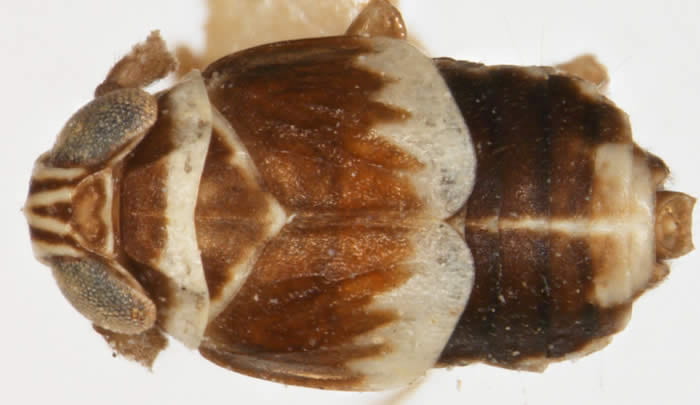Delphacid planthoppers are mostly small insects, usually between 2-4 mm (range 1.5 – ~8 mm). They have piercing/sucking mouthparts, in the form of a beak. The wings are membranous or somewhat thickened (especially when brachypterous), and held tent like; the wings may be clear or patterned. The hind legs are jumping (a feature that is true of essentially the entire suborder). Among the planthoppers (i.e., the superfamily Fulgoroidea), the family Delphacidae is easily recognized by examining the hind legs. At the end of the tibiae (near the “foot”) of each of the hind legs, there is a movable spur (the “calcar”) that is found only in delphacids (see images below). The spur is large and mobile, apparently used to assist in jumping. The calcar takes different forms in different groups of delphacids. Most commonly it is flattened and rather curled, with a row of fine black-tipped teeth along the posterior margin. However, in very basal (i.e., “primitive”) delphacid lineages, the calcar is rounded or quadrate in cross-section and lacks the fine teeth.
Delphacodes puella – a common delphacid in the eastern United States
The spur (calcar) at the apex of the hind tibiae of Delphacidae. A. Asiracinae, B. Plesiodelphacinae, C. Stenocraninae, D. Delphacinae, Tropidocephalini
The calcar of Neomegamelanus
Wing polymorphism and dispersal
Most species of delphacid planthoppers – along with certain Issidae, Dictyopharidae and other planthopper groups – can have different wing forms when adults within a species or population. Adults may be either long-winged (macropterous, or dispersal forms, with fully developed flying wings) or short-winged (brachypterous, adult wings not functional for flying) (see figure) within a single population of a species. The proportion of long-winged and short-winged forms in planthopper populations varies tremendously dependent on the species involved and population density. Some planthopper species are nearly all long-winged, with short-winged individuals rare. Other species are can be nearly all short-winged. For species that tend to be short-winged, crowding (or poor host plant quality) will cause nymphs to develop into long-winged (dispersal) forms instead, thus high population densities of usually short-winged species will develop functional flying wings for dispersal (the mechanism has recently been found to be an insulin receptors). For some planthopper species, long-winged forms are unknown (but almost certainly occur, except perhaps in orgeriine dictyopharids ).
A short-winged (non-flying) and long-winged (flying) delphacid planthopper of the same species (adapted from Asche, 1985).
A Tagosodes nymph in Florida (photography by Lyle Buss)
Akemetopon comptum brachypter (adult)
Short-winged adults are easily mistaken for immatures since they do not have functional wings. Short-winged adults and immatures can be distinguished (even in the field) with experience. Generally, adults have membranous wings that meet (or nearly meet) for some distance along the midline of the abdomen; whereas nymphs have thickened wings that are at an angle so that they do not meet along the midline of the back over the abdomen.
Planthopper species that are mostly short-winged are easily overlooked and some are rarely collected, particularly when the host plant is unknown.
Many – but not all – planthopper species in the eastern United States do better in moist or wet situations (and years) than they do in dry situations or years. Delphacid populations in particular will decline precipitously during droughts. Populations of individual species may therefore be highly variable between years — abundant one year, but nearly absent the next.
Planthoppers tend to be less common in successional habitats than they are in ecologically stable habitats. Particularly with the short-winged planthoppers, habitats that are maintained in a similar condition for a long period of time tend to be more productive. Natural habitats that are ecologically stable such as grassy balds or wet meadows are particularly attractive localities for finding planthoppers.
Some species migrate long distances. This is particularly well known for the brown rice planthopper, Nilaparvata lugens, a major rice pest, migrates from tropical southern China north to Japan in large numbers. Other delphacid species are known or have been suggested as having similar (albeit less dramatic) migratory habits.
Nilaparvata lugens from Entomology today; brachypterous adult (left), fully-winged adult (right)






